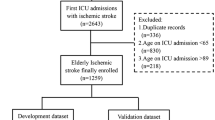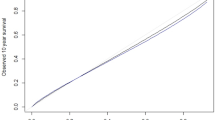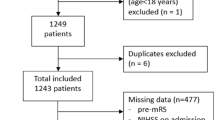Abstract
Context
Numerous models have been presented for the prognosis in acute stroke; however they have been criticized for being difficult to use, and few have been validated in independent samples.
Objectives
To develop simple risk score models for 1-year mortality in acute stroke in patients > 60 years old and validate the models.
Design
From a cohort of 2321 consecutive patients > 60 years of age with acute stroke in one hospital, we randomly selected 800 patients for chart review. Among 737 patients with validated acute stroke, we randomly split the sample into (1) a derivation (60%; n = 442) and (2) a validation sample (40%; n=295).We used logistic regression to develop three models with 2- covariates and a corresponding risk score from the derivation sample. The models were validated using area under the receiver operating curves.
Results
Three risk score models for 1-year mortality after stroke were developed using combinations of age, Canadian Neurological Scale score (CNSscore) (≥3.5 = 0, >3.5 = 1), Charlson comorbidity index and stroke type (ischemic = 0, hemorrhagic = 1). Both 2-variable (Age -60 + (30*CNSscore)), 3-variable (Age -60 + (30*CNSscore) + 4*Charlson)) and 4-variable (Age -60 + (25*CNSscore) + (5*Charlson) + (18*Stroke type)) models reliably predicted the outcome with an area under the receiver operating curve ranging 0.71 to 0.72.
Conclusions
Simple models incorporating two to four covariates reliably predicted 1-year mortality. Such models can be used to stratify prognosis in clinical practice, research or intervention trials.
Similar content being viewed by others
References
Benesch C, Witter DM Jr, Wilder AL, Duncan PW, Samsa GP, Matchar DB (1997) Inaccuracy of the International Classification of Diseases (ICD-9-CM) in identifying the diagnosis of ischemic cerebrovascular disease. Neurology 49:660-64
Boysen G, Christensen H (2001) Stroke severity determines body temperature in acute stroke. Stroke 32:413-17
Broderick J, Brott T, Kothari R, Miller R, Khoury J, Pancioli A, Gebel J, Mills D, Minneci L, Shukla R (1998) The Greater Cincinnati/Northern Kentucky Stroke Study: preliminary first-ever and total incidence rates of stroke among blacks. Stroke 29:415-21
Charlson ME, Pompei P, Ales KL, MacKenzie CR (1987) A new method of classifying prognostic comorbidity in longitudinal studies: development and validation. J Chronic Dis 40:373-83
Counsell C, Dennis M (2001) Systematic review of prognostic models in patients with acute stroke. Cerebrovasc Dis 12:159-70
Demchuk AM, Buchan AM (2000) Predictors of stroke outcome. Neurol Clin 18:455-73
Ellekjaer H, Holmen J, Kruger O, Terent A (1999) Identification of incident stroke in Norway: Hospital discharge data compared with a population- based stroke register. Stroke 30:56-0
Fiorelli M, Alperovitch A, Argentino C, Sacchetti ML, Toni D, Sette G, Cavalletti C, Gori MC, Fieschi C (1995) Prediction of long-term outcome in the early hours following acute ischemic stroke. Arch Neurol 52:250-55
German Stroke Study Collaboration (2004) Predicting outcome after acute ischemic stroke: an external validation of prognostic models.Neurology 24; 62(4):581-85
Goldstein LB (1998) Accuracy of ICD- 9-CM coding for the identification of patients with acute ischemic stroke: effect of modifier codes. Stroke 29:1602-604
Goldstein LB, Chilukuri V (1997) Retrospective assessment of initial stroke severity with the Canadian Neurological Scale. Stroke 28:1181-184
Hajat C, Hajat S, Sharma P (2000) Effects of poststroke pyrexia on stroke outcome: a meta-analysis of studies in patients. Stroke 31:410-14
Hankey GJ, Jamrozik K, Broadhurst RJ, Forbes S, Burvill PW, Anderson CS, Stewart-Wynne EG (2000) Five-year survival after first-ever stroke and related prognostic factors in the Perth Community Stroke Study. Stroke 31:2080-086
Kammersgaard LP, Jorgensen HS, Rungby JA, Reith J, Nakayama H, Weber UJ, Houth J, Olsen TS (2002) Admission body temperature predicts long-term mortality after acute stroke: the Copenhagen Stroke Study. Stroke 33:1759-762
Lee DS,Austin PC, Rouleau JL, Liu PP, Naimark D, Tu JV (2003) Predicting mortality among patients hospitalized for heart failure: derivation and validation of a clinical model. JAMA 290:2581-587
Moons KG,Harrell FE, Steyerberg EW (2002) Should scoring rules be based on odds ratios or regression coefficients? J Clin Epidemiol 55:1054-055
Petty GW, Brown RD Jr, Whisnant JP, Sicks JD, O'Fallon WM, Wiebers DO (2000) Ischemic stroke subtypes: a population-based study of functional outcome, survival, and recurrence. Stroke 31:1062-068
Ronning OM,Guldvog B (1998) Stroke units versus general medical wards, I: twelve- and eighteen-month survival: a randomized, controlled trial. Stroke 29:58-2
Stavem K, Lossius M, Ronning OM (2003) Reliability and validity of the Canadian Neurological Scale in retrospective assessment of initial stroke severity. Cerebrovasc Dis 16:286-91
Stavem K, Ronning OM (2002) Survival of unselected stroke patients in a stroke unit compared with conventional care. QJM 95:143-52
Sumer MM, Ozdemir I, Tascilar N (2003) Predictors of outcome after acute ischemic stroke. Acta Neurol Scand 107:276-80
Tilling K, Sterne JA, Rudd AG, Glass TA, Wityk RJ, Wolfe CD (2001) A new method for predicting recovery after stroke. Stroke 32:2867-873
Tu JV, Naylor CD (1997) Clinical prediction rules. J Clin Epidemiol 50:743-44
Wang Y, Lim LL, Heller RF, Fisher J, Levi CR (2003) A prediction model of 1-year mortality for acute ischemic stroke patients. Arch Phys Med Rehabil 84:1006-011
Wang Y, Lim LL, Levi C, Heller RF, Fischer J (2001) A prognostic index for 30-day mortality after stroke. J Clin Epidemiol 54:766-73
Weimar C, Konig IR, Kraywinkel K, Ziegler A,Diener HC (2004) German Stroke Study Collaboration. Age and National Institutes of Health Stroke Scale Score within 6 hours after onset are accurate predictors of outcome after cerebral ischemia: development and external validation of prognostic models. Stroke 35:158-62
Weimar C, Roth M, Willig V, Kostopoulos P, Benemann J, Diener HC (2006) Development and validation of a prognostic model to predict recovery following intracerebral hemorrhage. J Neurol 253:788-93
Weimar C, Ziegler A, Konig IR, Diener HC (2002) Predicting functional outcome and survival after acute ischemic stroke. J Neurol 249:888-95
Weir NU, Counsell CE, McDowall M, Gunkel A, Dennis MS (2003) Reliability of the variables in a new set of models that predict outcome after stroke. J Neurol Neurosurg Psychiatry 74:447-51
Author information
Authors and Affiliations
Corresponding author
Rights and permissions
About this article
Cite this article
Solberg, O.G., Dahl, M., Mowinckel, P. et al. Derivation and validation of a simple risk score for predicting 1-year mortality in stroke. J Neurol 254, 1376–1383 (2007). https://doi.org/10.1007/s00415-007-0555-2
Received:
Revised:
Accepted:
Published:
Issue Date:
DOI: https://doi.org/10.1007/s00415-007-0555-2




